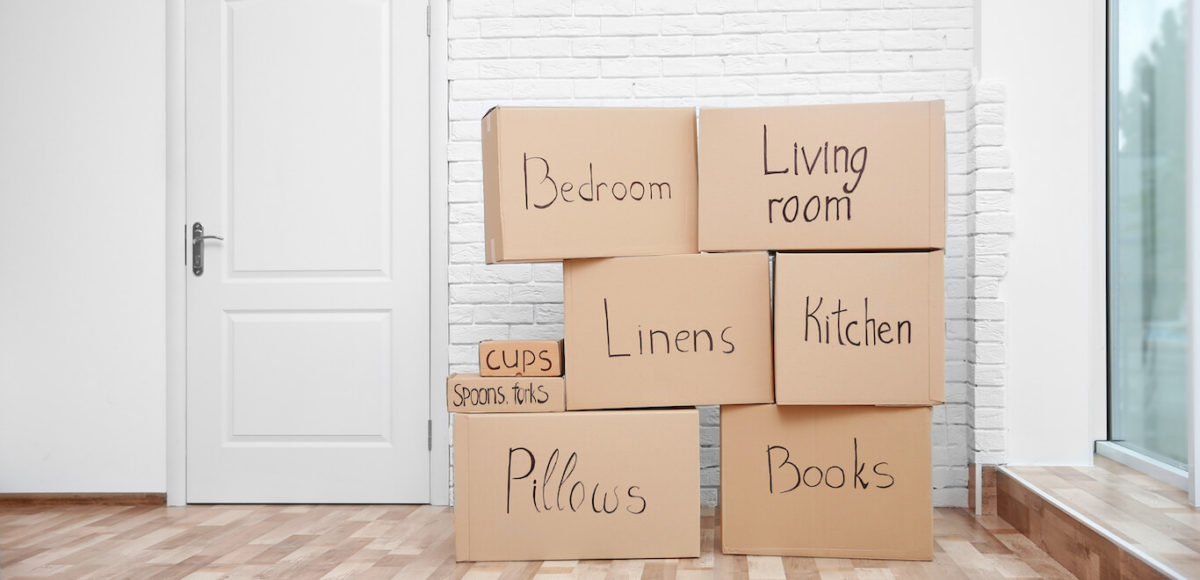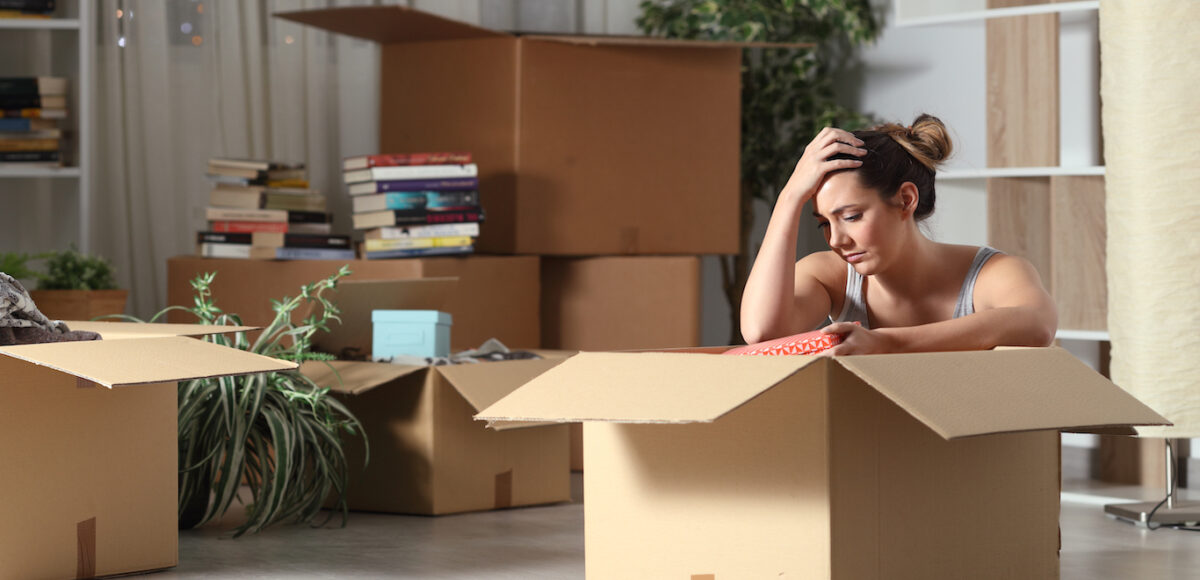Moving into a new place can be exciting—but also a little overwhelming. Where do you start? How did you end up with so much stuff, anyway? And how many boxes will it take to pack all of it? We’re here to help break down one of the biggest mysteries of moving: “How many boxes do I need to move?” And we’ll throw in a few other moving tips for you, too!
Standard Moving Box Sizes
Didn’t know there were so many kinds of moving boxes? We’ve got your back. Here’s a breakdown of the standard moving box sizes and what items are ideal to pack in each.
Small: Standard size is 16″ x 12″ x 12″ (approx. 1.5 cubic feet). Ideal for packing books, small objects and kitchen gadgets.
Medium: Standard size is 18″ x 16″ x 18″ (approx. 2–3 cubic feet). Ideal for pantry items, small appliances and decorative items.
Large: Standard size is 18″ x 18″ x 24” (approx. 3–3.5 cubic feet). Ideal for bedding, towels, curtains, and throw pillows.
Extra Large: Standard size is 24″ x 20″ x 24″ (approx. 4+ cubic feet). Ideal for bulky but lightweight items like comforters, pillows and sports equipment.
Wardrobe Box: Standard sizes are 24” x 24” x 34” (approx. 11 cubic feet), 24” x 24” x 40” (approx. 13 cubic feet) and 24” x 24” x 48” (approx. 16 cubic feet). Designed for hanging clothes and includes a rod across the top. One box holds about 2 feet of hanging clothes.
Dish Barrel Box: Standard size is 18” x 18” x 28” (approx. 5.25 cubic feet). Double walled to pack fragile items and the best way to pack plates when moving. Inserts with grooves and partitions for glasses are available.
Mirror & Picture: Variety of sizes, typically adjustable. Thin and flat, designed to hold artwork and mirrors.
TV Box: Most boxes will extend 32” to 70”. Designed to protect flat-screen TVs.
Lamp: Standard size is 12” x 12” x 60”. Designed to protect lamps and other tall objects.
File Box: Standard size 15” x 12” x 10”. Designed with handles and removable tops, best for documents, books, and office supplies.
In addition to boxes, you’ll need a few additional things to pack. Be sure to get your hands on:
- Permanent markers
- Labels
- Bubble wrap
- Packing paper
How Many Boxes Do I Need for Each Room?
Now that you know what kind of boxes there are to use, we can move on to the next question: How many boxes do I need to move? As a general rule, most experts suggest 15 boxes per room, but every home is different. We’ll break it down a bit more for you.
How Many Moving Boxes to Pack a Bedroom
When planning to pack the bedroom, be sure to think about everything on your bedside table, jewelry and accessories, the random stack of books in the corner—not just clothes and bedding. Scale down 1–2 boxes for kids and guest rooms.
Here’s a general guideline of how many boxes you’ll need to pack a bedroom:
- 1 to3 small boxes
- 5 to 6 medium boxes
- 5 to 8 large boxes
- 4 to 6 wardrobe boxes
- 2 to 3 lamp boxes
- 2 to 3 mirror/picture boxes
Number of Moving Boxes Needed for Bathrooms and Laundry Room
You might be surprised by how many boxes you need for bathrooms and the laundry room —toiletries, towels, extra bedding, hair tools, and cleaning supplies add up fast.
Here’s what you’ll likely need per room:
- 2 to 3 small boxes
- 2 to 3 medium boxes
How Many Moving Boxes for a Living Room
Depending on the size of your living room, you’ll need the following boxes to pack books, magazines, throw pillows, blankets, lamps, and decor.
- 2 to 4 small boxes
- 2 to 4 medium boxes
- 2 to 4 large boxes
- 1 to 2 lamp boxes
- 2 to 4 mirror/picture boxes
- 1 TV box
Number of Moving Boxes Needed for a Kitchen
If you’re a home chef, err on the side of too many. If you tend to stick to takeout, you’ll probably be safe with the minimum.
- 2 to 4 small boxes
- 5 to 6 medium boxes
- 3 to 4 large boxes
- 4 to 6 dish barrel boxes
How Many Moving Boxes to Pack Your Dining Room
The dining room is probably the room that differs most from home to home. You may just have a table, chairs, and a piece of artwork—or you may have a sidebar full of barware, serveware, and extra table linens. Plan your boxes accordingly.
- 1 to 4 small boxes
- 2 to 4 medium boxes
- 2 to 4 dish barrel boxes
- 1 to 2 lamp boxes
- 1 to 2 mirror/picture boxes
How Many Boxes Needed to Pack Up Your Home Office
The number of boxes you may need for a home office depends on how much time you spend there. If you WFH regularly, you probably have a bigger setup than if you pop in for an hour or two.
- 2 to 4 file boxes
- 2 to 4 small boxes
- 1 to 2 medium boxes
- 1 to 2 lamp boxes
- 1 to 2 mirror/picture boxes
More Pro Tips
1. Do Your Research
Moving companies can be worth the expense, but be sure to investigate your options thoroughly so you get your money’s worth. Ask for recommendations and read reviews of different companies, get multiple quotes and in-home estimates, compare the bids, and ask questions before making your decision.
2. Pack smart
Think about how to pack boxes for moving and unpacking with ease and efficiency. Pack by room, then by like items. Make a room-by-room checklist of everything that needs to be packed to help determine what kind of boxes you will need and how many.
3. Label Every Box
Be sure to write the room the items belong in on the outside of the box. To minimize the hand cramps, you can also use colored dot stickers to denote the room. Make unpacking even easier by writing the specific kind of items on the box, too.
4. Plan For Immediate Use
Pack the things you will need to use immediately post move in separate boxes so you can access what you need easily even if you can’t unpack everything right away.
5. Don’t Overpack … But Avoid Empty Space, Too
Be careful not to pack a box too heavy, especially if you plan to move on your own without a moving company. Heavy boxes are more difficult to carry and may run the risk of breaking. Don’t waste valuable packing space by leaving a box partially empty, either—the fewer boxes the better. Plus, empty space leaves room for fragile items to shift, making them more likely to break in transit. Use bubble wrap and paper to fill the extra space and pad the items.
6. Don’t Pay for Moving Boxes
There are plenty of places to get free boxes! Check out our complete list. If you do need to purchase some, head to your local hardware store and see if you can buy in bulk.
7. Reduce, Reuse, and Recycle to Save on Supplies
To cut back on the amount of packing paper you’ll need to purchase, start saving newspapers, magazines, and bubble wrap that comes in packages.
8. Include Your Kids in the Process
Empower your kiddos to help out as much as they are able and have simple activities planned (even just a few movies downloaded on your iPad) to keep little ones occupied and out of the way on moving day.
9. Declutter Before You Move
Feeling overwhelmed with everything you have to pack and wondering how to get rid of stuff before moving? Use up half-empty cleaning supplies and household goods (buy travel size if you need more before the move), throw away old makeup and toiletries, donate or throw away anything you don’t wear or use, do a fridge and pantry clean out (goodbye, expired salad dressings!) and put aside sentimental things for last.
Let ApartmentSearch Help You Find Your Dream Apartment
Are you ready to pack up and move? Let ApartmentSearch help! Our advanced search filters and tools have simplified the apartment searching process. Save yourself the headache of sifting through hundreds of listings and narrow down your selection based upon your budget and needs so you can put your time and energy into packing.




